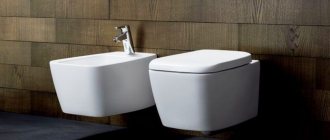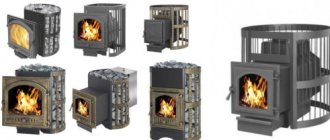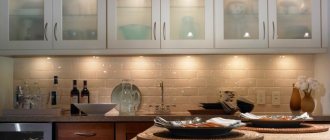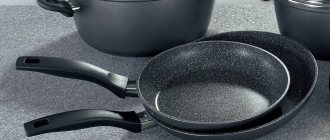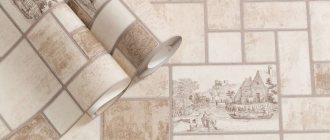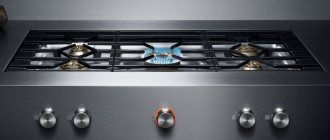In addition to traditional toilets, wall-hung structures have become very popular, allowing optimal use of the usable space of the room. And from an aesthetic point of view, they look much better than floor-standing models. Do you agree?
The plumbing equipment market offers several options, each of which has its own installation and operation features. We will tell you how to choose an installation for a toilet, what characteristics and parameters are important to take into account.
In addition, we will describe the operation scheme of the suspended system, outline its pros and cons, and also name the best manufacturers of plumbing fixtures. The material contains a video with expert advice on choosing installations.
What is an installation system?
This name refers to a steel structure that is mounted into the wall. It is a frame onto which the necessary fittings, a toilet or other types of hygienic devices (sink, bidet) are attached.
The toilet installation, made of a durable metal alloy, is used to attach suspended plumbing fixtures, ensuring the stability and reliability of the entire structure
All technical communications are covered with a plasterboard false wall, which gives the interior a pleasant, neat design. The wall-hung toilet and the panel with the flush button remain visible, taking up minimal space.
Image gallery
Photo from
Hanging sanitary ware in the bathroom
Wall-hung toilet on the interior partition
Attaching the toilet and bidet to the installation
Covering the installation with a false wall
Control
The controls should be stylish and not go beyond the design of the room in which the installation is installed. Then the design will not spoil the room in which it is installed.
However, management must also be assessed by technical indicators. All controls must be ergonomic (comfortable). Otherwise, using the design will not be very convenient. You need to make sure that the controls can be easily accessed. If you need to disassemble something for this, then it is not advisable to buy such a model.
It is important that the structure can be repaired without dismantling the tiled wall.
Components of the system
The complete kit consists of the following components.
Installation . This important element is made of durable steel, which is usually coated with an anti-corrosion coating. The hydraulic piping of the toilet and/or other plumbing fixtures is attached to the frame, and connecting components (couplings, mounting pins) are installed.
A toilet tank is mounted to the structure, which plays an important role in the operation of the system, since its quality and durability largely depend on this component.
To prevent corrosion and leakage, the tank is usually made of high-quality plastic, and silicone or improved rubber is used to gasket the flush valve.
To prevent water overflow, which can lead to flooding of the apartment, an emergency drain is provided. Manufacturers of modern plumbing comply with European standards, according to which the noise level during operation of the tank should not exceed 17 dB.
Toilet . Modern designs of installation systems are, as a rule, universal: they are suitable for hygienic devices of various brands. In addition to hanging models, frames are also used for some variants of floor-mounted plumbing fixtures, namely for modifications with a “hidden tank”.
The hygiene products on sale come in a variety of colors (from traditional white to black and acid-bright tones), finishes and designs. Most models are traditionally made of earthenware or porcelain, but you can find options from other materials: acrylic, metal, glass.
When choosing a model, it is advisable to pay attention to the toilet lid: they can be regular or with a “half-lift”. The latter option guarantees smooth closing, which prevents plumbing from mechanical damage during sudden slamming.
An important part of the toilet installation is the flush panel or button, which often has an elegant design and a wide variety of colors.
Flush button . A small but important component of the installation system is the external panel with the flush button.
This part can have various modifications:
- with “flush-stop” mode – in this case, flushing can be stopped by pressing the panel again;
- with two flush options - economical, which involves flushing half of the tank, and general with full flushing;
- non-contact - activated by infrared rays.
Flush panels can vary greatly in color and design, and are often a real highlight of a toilet or bathroom.
Flush button
Another important factor when choosing an installation for a toilet is the design of the flush button.
This part comes in two varieties:
- For 2 modes
. These buttons are easy to use and maintain. The available functions of the elements are “stop” and “flush”. Products of this type do not require electrical power or a battery pack. The high reliability of dual-mode buttons is explained by the simplicity of their design. - Contactless
. Devices of this type are equipped with special sensitive motion sensors that allow them to respond to human presence. The signal from the sensor is sent to an internal mechanism that turns the water supply on or off. Contactless buttons have a more complex design and are quite expensive. Their installation and configuration will require certain qualifications. The strengths of sensory devices include hygiene, ease of use and presentable appearance. Unlike simpler devices, contactless buttons do not protrude beyond the surface of the device. No human intervention is required to operate the device.
Modern models in the interior of bathrooms
Various models of wall-hung toilets will fit perfectly into the interiors of toilets/bathrooms decorated in all possible styles - from classic to high-tech and art deco.
However, before you go to the store, you should think in advance not only about the preferred design, but also about the place where the plumbing fixtures will be located, since this factor leaves an imprint on the choice of a hygienic device.
There are various options for installing a toilet installation in the interior.
Standard design layout . For normal installation near one of the walls, conventional frames (frame or wall mounted) made by various manufacturers are suitable.
Installation on both sides of the partition . In this case, it is better to prefer a volumetric design, in which you can hang the components of the plumbing kit on both sides of the wall.
In this case, the flush button is mounted on the upper edge of the partition in a horizontal rather than frontal position. This type of installation is especially suitable for wooden floors, which are often found in country houses, dachas, and cottages.
Corner version of the system . For small spaces, a corner installation is ideal.
A corner wall-hung toilet is perfect for arranging compact spaces. This model has an elegant appearance and occupies a minimum of usable space.
In this case, you can use two installation options:
- Purchase a corner mounting module.
- Choose a standard frame, but purchase special fasteners to place it in the corner.
Such structures at the junction of walls look airy and take up minimal space.
On an island or under a window . This option allows you to optimally use the section of the wall under the window or zoning the room. For such placement, it is advisable to select small frame systems, the height of which does not exceed 82 cm.
Installation in line . In this case, a single installation structure is installed that combines several plumbing items at once: toilet, sink, bidet.
The linear arrangement of the installation allows you to attach not only a wall-hung toilet, but also other types of hygienic devices, such as a sink and a bidet, to the built-in frame
In this way, you can install all the necessary equipment at one time, decorating the room in the same style.
Types of installations by design
It is customary to distinguish between two main types of such structures, which differ not only in technical characteristics, but also in the nuances of installation.
No. 1. Block (mounted) model and its features
This is the simplest and most cost-effective installation system, but it has a significant limitation in use - it can only be installed on a load-bearing main wall. The design includes a plastic tank, mounting plates with anchors, and a set of studs designed for attaching the toilet.
Installing a block installation
The hanging structure is placed in a niche made in the wall. When attaching the frame, it is important to determine the height of the installation, and then mark marks in the right places for installing the fastening.
The block design of the toilet installation is simple and inexpensive, but it is only compatible with load-bearing floors
Using a hammer drill, holes are drilled into which dowels are driven in, onto which the installation with a screwed-on tank is hung. After checking the reliability of the installed gaskets, the drain container is connected to the communications.
The pins necessary for hanging the bowl of the hygiene device are inserted into the pre-made holes. Then the space under the block is bricked: if there are voids between the false and main walls, the toilet will put pressure on the partition, as a result of which its finishing (for example, tiles) may crack.
The final stage is to seal the hole with a waterproof plasterboard sheet (usually in two layers), which provides an inspection window, closed by a panel with a drain button. The toilet is hung last, after all installation work is completed.
No. 2. Characteristics of frame installation
A more complex, versatile, and expensive option is the frame design. This is a durable steel frame with an anti-corrosion coating, which is supplied with the fittings required for fastening the installation and plumbing fixtures mounted on it.
Scheme of a standard frame installation for a toilet with typical dimensions marked on it. This design is recommended for most rooms
Such a system can be installed in any room, regardless of the wall material and their strength. However, it should be taken into account that the quality of the partitions directly affects the fastening option. For load-bearing floors, it is better to prefer wall mounting, in which the entire load falls on the wall.
If you decide to place the installation next to a plasterboard or foam block partition, it is advisable to choose a floor-mounted option: in this case, the frame is installed on special legs.
There is also a combined modification that provides for securing the model using four holes to both vertical and horizontal surfaces.
All installation frame systems are adjustable in height using legs (about 20 cm), which is very convenient, since this function allows you to install the device at the required distance from the floor covering.
One can also note the great functionality of such structures. When installing it, you can provide a shelf or ledge in the wall.
Installation of frame structures
Initially, you should determine the location of the frame, which can be attached to the wall or installed on the floor. At the same time, you need to determine the height at which the toilet will be located.
After this, the tank is installed. A water pipe is supplied to it and connected to the inlet fitting.
You should not use flexible hoses, the service life of which is much shorter than the service life of the toilet and flush cistern.
Installation of a frame installation for a toilet can be done quite easily, but this work requires attention and accuracy when connecting all the parts
The toilet sewer outlet is connected to the riser using corrugation or directly. Upon completion of the procedure, it is important to check the strength of the connection by pouring about 3 liters of water.
The final stage is finishing the installation with a double sheet of plasterboard (GKVL), in which the necessary holes are cut, after which the drain button is installed and the false wall is finished.
Read more about the technologies for installing block and frame systems in this article.
Types of construction and installation method
Typically, the type of installation depends on where the entire weight of the structure needs to be transferred. What types of construction are more popular?
The block installation system is suitable for those who can attach the installation to a solid wall. During installation work you cannot do without anchor bolts, but after installation the entire installation will be located in a suspended state. This way you will save free space.
The frame installation system is installed on the floor. This design can be used in false walls and partitions made of plasterboard. This type of installation is optimal for those who would like to adjust the installation height of the device.
Dimensional range of toilet installations
When choosing an installation, you need to pay attention to its parameters. This is especially important if a specific space has already been allocated for installation of the system.
The standard version of block systems has the following dimensions:
- width – 50 cm;
- depth – 10-15 cm;
- height – 1 m.
A typical frame structure usually has the following parameters:
- width – 50-60 cm;
- depth – 15-30 cm;
- height – 0.8-1.4 m.
When choosing frame installations for placing plumbing under a window, it is better to give preference to lower modifications with a height of 80-82 cm. Low, wide structures that reduce the load on the walls are preferably used in houses with wooden partitions.
To better meet customer needs, many companies produce non-standard modifications of models.
The assortment of the German company TESE includes an installation with a depth of only 8 centimeters. A slightly wider version of 9 cm is produced by the Spanish manufacturer Roca .
A miniature design with a width of 30 cm is offered by the Italian company Migliore , and in the size range of the Dutch company WiSA Excellent there is an option with a similar parameter of 38 cm.
The best manufacturers of wall-hung sanitary ware
The most popular brands that produce installations for toilets include Turkish Vitra , Spanish Roca , Polish Cersanit , famous German companies TECE , Viega , Grohe , Russian brand IDDIS , famous Swiss brand Geberit , Dutch company WiSA Exellent , Italian Migliore , Czech Alcaplast .
According to user surveys on specialized forums, installations for toilets from the Swiss company Geberit are of the best quality, providing a number of useful functions, for example, eliminating unpleasant odors
Based on surveys of participants in specialized forums, the following five best manufacturers of suspended structures were determined:
- The first place was taken by Geberit , which produces installation systems with a unique seamless tank.
- The second was shared by Grohe / Viega .
- The third went to the German manufacturer TECE .
- Cersanit and Wisa settled on the fourth .
- Fifth place was taken by the budget brand Alcaplast .
In addition to the durability and quality of the products, respondents also paid attention to the design of the models, in particular, the beauty of the buttons. In their opinion, panels produced by Tece , Geberit and Vierga .
When purchasing plumbing equipment, it is important to remember that even high-quality devices can fail due to factors such as improper installation, poor water quality, and violation of operating rules.
The best manufacturers of toilet installations
| Name | A country | Characteristics |
| GROHE | Germany | Guarantee of quality, reliability, best installation of the structure. |
| CERSANIT | Netherlands | Full set. |
| GEBERIT | Switzerland | Resistance to high loads, innovative assembly technologies. |
| VITRA | Türkiye | Compact size, powder coating is corrosion resistant. |
| BERGES | Germany | Heat-resistant sound insulation. |
Tips before purchasing attachments
To install suspended plumbing, you must purchase the following set of components:
- Installation system . The choice of modification directly depends on the quality of the walls: a block version is suitable only for strong load-bearing structures, while a frame version is compatible with plasterboard or foam block partitions. An important point is the planned location of plumbing fixtures.
- A wall-hung (floor-mounted) toilet bowl with the desired lid. When purchasing, you should definitely check with the seller whether the kit includes fasteners and an adapter designed for installing a flush elbow. If the answer is negative, you will have to buy them additionally (it is advisable to choose parts from the same company).
- The tank and flush must be purchased separately if the ready-made kit does not include such elements.
- Soundproofing pads . An important component that will provide additional sound insulation, eliminating the sounds of drained water.
When purchasing plumbing fixtures, you must check the components, checking their availability with the list in the instructions.
In addition to the main frame or block type structure, the installation kit also includes various fastening connections and pins on which the toilet is installed
When choosing a model, you should also pay attention to the additional functions available, for example, the absorption of unpleasant odors or the ability to save water. You should also ask the seller how commercially available the components of this company are, if they have to be purchased separately.
Be sure to keep the warranty card for the purchased product.
Four misconceptions about installing toilets
Myth 1. Since all technical communications are located inside the system, in the case of the simplest installation repair or replacement of a separate component, you will have to completely destroy the false wall, damaging the cladding or other finishing.
Thanks to a specially left window under the drain panel, you can access the fittings at any time to eliminate the most common faults
Refutation. The drainage system can be easily accessed through the inspection window, which opens when the panel with the flush button is removed. This design solution makes it possible to easily correct deficiencies in the operation of the shut-off valve and other fittings and replace them.
It is worth adding that the service life of the drain tank, made of durable plastic, is usually equal to the period of operation of the entire system.
Myth 2 . If any component of the toilet installation breaks, it will be difficult to purchase it on the open market.
Refutation. Finding spare parts for the most popular models of hanging plumbing is not difficult; they are widely available in specialized stores. If in doubt, you can ask the seller in advance how available parts of a particular brand are on the market.
Myth 3 . Wall-hung toilets are unreliable and fragile. It is unlikely that such plumbing will be suitable for overweight people.
Refutation. This category of plumbing fixtures is mounted on a durable frame made of steel. The frame is securely built into the wall, which ensures its strength and stability. Manufacturers of such products guarantee that they can withstand a weight of 200-400, and some models even 800 kilograms.
Myth 4 . Installing a wall-hung toilet requires a lot of space, since part of the usable area will be taken up by a false wall.
Refutation. Wall-hung plumbing fixtures are located directly against the wall, so space is allocated for installation, which is usually occupied by the tank of a traditional model of a hygienic device.
When placing the structure in a niche with communications, it is possible to even slightly increase the free space of the toilet or bathroom.
Equipment
Before purchasing, you need to check the package contents. The kit should include a supporting frame, controls and fasteners, as well as an adapter and a drain tank. We must not forget about the elements of sound insulation.
If there is something missing in the package, then you will have to go to the store and look for the missing part. This can cause problems, because if you have a rare model of installation, it will be difficult to find spare parts for it. Therefore, check the package after opening the installation box.
The technical content of the installation is located in the wall, and only the controls will be on the outer surface. If you remove them, you can gain access to all installation systems. This is convenient for repairs.
Popular ready-made solutions (installation + drain button):
Geberit Switzerland
Installation for wall-hung toilet Geberit Duofix Delta 458.124.21.1 3 in 1 with flush button
Article 458.124.21.1
Dimensions, cm (w) 50×112
10 290 ₽
Look
Grohe Germany
Installation for wall-hung toilet Grohe Rapid SL 38775001 4 in 1 with flush button
Article 38775001
Dimensions, cm (w) 50×113
10 890 ₽
Look
Grohe Germany
Installation for wall-hung toilet Grohe Rapid SL 38750001 4 in 1 with flush button
Article 38750001
Dimensions, cm (w) 50×113
11 040 ₽
Look
Geberit Switzerland
Installation for wall-hung toilet Geberit Duofix Delta Plattenbau 458.122.21.1 4 in 1 with flush button
Article 458.122.21.1
Dimensions, cm (w) 50×112
15 015 ₽
Look
TECE Germany
Installation for wall-hung toilet TESE Now 4 in 1 with flush panel, white
Article K400400
Dimensions, cm (width) 50x112x16
16 650 ₽
Look
TECE Germany
Installation for wall-hung toilet TESE Ambia 4 in 1 with flush panel, white
Article K440200
Dimensions, cm (width) 50x112x16
15 750 ₽
View All ready-made solutions (installation + drain button)
Conclusions and useful video on the topic
In the video below you can hear advice on choosing an installation for a toilet directly from a specialist:
Wall-hung toilets and other hygienic appliances combine reliability, convenience and attractive appearance. With their help, you can transform the interior of any sanitary room, giving it airiness and elegance.
If you have anything to add, or have any questions about choosing an installation for the toilet, you can leave comments on the publication. The comment form is in the lower block.
Recommendations for selection
When deciding on the model of the installation system for the toilet, it is necessary to take into account its dimensions and features of the location.
Based on their dimensions, installations are usually divided into the following types:
- Standard
. A good option for those cases when the toilet is installed in a regular bathroom, without any problems with free space. In most cases, standard installations have a width of 50 cm, an installation depth of 12 cm and a height of 112 cm. Quite often, they are used to equip standard apartments where too large structures would be inappropriate (read also: “Installing a toilet installation - system options, installation guide" ). - Low
. This model is designed for rooms where height difficulties arise when installing a toilet. The most common reason is a low-lying window sill, which is typical for small apartments. In addition, such restrictions may arise due to other architectural features of the toilet. Especially for such cases, installations of small height (up to 80 cm) are available for sale. If you need to install a toilet in a bathroom with limited space, it is recommended to use a low frame. - Paired
. An installation option for office and business buildings, where several toilets have to be installed on a small toilet area. Paired frames have seats on different sides, which makes it possible to place the toilet in different rooms. The frame in this case is located inside the partition. - Angular
. In the process of arranging a bathroom, sometimes a decision is made to install a toilet in the corner of the room. To realize your plans, there are two ways - use a special corner installation, or order a corner block. The first option is more affordable financially, because... The cost of corner toilets is very high. - Linear
. In public toilets, toilets are usually located in one line. In addition, bidets or urinals can be installed next to them. To implement such projects, linear installations with a reinforced structure were developed.
Thanks to the wide range of models, there is usually no difficulty in choosing an installation. To understand which installation is better, it is necessary, first of all, to study the engineering features of the toilet installation location. It is not recommended to rush in this matter, because... In case of an error, installation of the structure can cause serious difficulties and take a long time.
